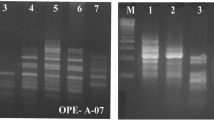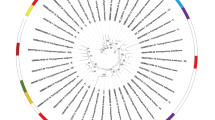Abstract
The internal transcribed spacers of rDNA are among the most important molecular markers used in the taxonomy and phylogeny of entomopathogenic nematodes. However, their ease of use and the results they provide can be confounded by the presence of intra-individual variability. In the present study we screened 40 strains of S. feltiae and S. kraussei and nine strains from the “glaseri” group. In two selected strains of S. feltiae, and one strain each of S. kraussei and S. glaseri, PCR products of four virgin females were cloned, and five clones per individual female were sequenced and analyzed. In S. feltiae, intra-individual variability was compared with intraspecific variability. We revealed a high frequency of intra-individual variability, which reached 65 % in S. feltiae, 30 % in S. kraussei, and almost 90 % in the “glaseri” group. Analysis of the cloned products showed intra-individual variability in each of the tested strains and individuals. Maximum within-individual variability was over 1 % in S. feltiae and S. kraussei, and in S. glaseri reached up to 4 %. In S. feltiae, intra-individual variability equaled the variability among S. feltiae strains from different parts of the world. Our data show that intra-individual variability in the ITS regions is quite frequent in entomopathogenic nematodes. The implications of this fact to the group taxonomy are discussed.


Similar content being viewed by others
References
Adams BJ, Peat S, Dillman AR (2007) Phylogeny and evolution. In: Nguyen KB, Hunt DJ (eds) Entomopathogenic nematodes: Systematics, pylogeny and bacterial symbionts nematology monographs and perspectives 5. Brill, Leiden, pp 693–733
Boemare NE, Akhurst RJ, Mourant RG (1993) DNA relatedness between Xenorhabdus spp (Enterobacteriaceae), symbiotic bacteria of entomopathogenic nematodes, and a proposal to transfer Xenorhabdus luminescens to a new genus, Photorhabdus gen nov. Int J Syst Bacteriol 43:249–255
Cardoso JMS, Fonseca L, Abrantes I (2010) Genetic diversity of ITS sequences of Bursaphelenchus xylophilus. Genet Mol Res 11:4508–4515
Desta TA, Mulawarman M, Wayenberge L, Moens M, Viaene N, Ehlers RU (2011) Identification and intraspecific variability of Steinernema feltiae strains from Cemoro Lawang village in Eastern Java, Indonesia. Russ J Nematol 19:21–29
Feliner GN, Larena BG, Aguilar JF (2004) Fine-scale geographical structure, intra-individual polymorphism and recombination in nuclear ribosomal internal transcribed spacers in Armeria (Plumbaginaceae). Ann Bot 93:189–200
Georgis R (2002) The biosys experiment: an insider’s perspective. In: Gaugler R (ed) Entomopathogenic nematology. CABI publishing, Wallingford, pp 357–372
Hall TA (1999) BioEdit: a user–friendly biological sequence alignment editor and analysis program for Windows 95/98/NT. Nucleic Acid Symp Ser 41:95–98
Hoste H, Chilton NB, Gasser RB, Beveridge I (1995) Differences in the second internal transcribed spacer (ribosomal DNA) between five species of Trichostrongylus (Nematoda: Trichostrongylidae). Int J Parasitol 25:75–80
Kaya HK, Stock SP (1997) Techniques in insect nematology. In: Lacey LA (ed) Manual of techniques in insect pathology. Academic Press, San Diego, pp 281–324
Kuwata R, Shigematsu M, Yoshiga T, Yoshida M, Kondo E (2006) Intraspecific variations and phylogenetic relationships of steinernematids isolated from Japan based on the sequences of the ITS region of the nuclear rRNA gene and the partial mitochondrial COI gene. Japan J Nematol 36:11–21
Leles D, Araujo A, Vicente AC, Iniguez AM (2010) ITS1 intra–individual variability of Ascaris isolates from Brazil. Parasitol Int 59:93–96
Librado P, Rozas J (2009) DnaSP v5: a software for comprehensive analysis of DNA polymorphism data. Bioinformatics 25:1451–1452
Mráček Z (1980) The use of “Galleria traps” for obtaining nematode parasites of insect in Czechoslovakia (Lepidoptera: Nematoda, Steinernematidae). Acta Entomol Bohemoslov 77:378–382
Mráček Z, Bečvář S, Kindlmann P, Jersáková J (2005) Habitat preference for entomopathogenic nematodes, their insect hosts and new faunistic records for the Czech Republic. Biol Control 34:27–37
Nei M, Kumar S (2000) Molecular evolution and phylogenetics. Oxford University Press, New York
Nguyen KB (2007) Methodology, morphology and identification. In: Nguyen KB, Hunt DJ (eds) Entomopathogenic nematodes: systematics, phylogeny and bacterial symbionts nematology monographs and perspectives 5. Brill, Leiden, pp 59–119
Poinar GO Jr (1979) Nematodes for biological control of insects. CRC Press, Boca Raton
Rzhetsky A, Nei M (1992) A simple method for estimating and testing minimum evolution trees. Mol Biol Evol 9:945–967
Saitou N, Nei M (1987) The neighbor–joining method: a new method for reconstructing phylogenetic trees. Mol Biol Evol 4:406–425
Spiridonov SE, Reid AP, Podrucka K, Subbotin SA, Moens M (2004) Phylogenetic relationships within the genus Steinernema (Nematoda: Rhabditida) as inferred from analyses of sequences of the ITS1–58S–ITS2 region of rDNA and morphological features. Nematology 6:547–566
Tamura K, Stecher G, Peterson D, Filipski A, Kumar S (2013) MEGA6: molecular evolutionary genetics analysis version 60. Mol Biol Evol 30:2725–2729
Tang J, Toe L, Back C, Unnasch TR (1996) Intra-specific heterogeneity of the rDNA internal transcribed spacer in the Simulium damnosum (Diptera: Simuliidae) complex. Mol Biol Evol 13:244–252
Vollmer SV, Palumbi SR (2004) Testing the utility of internally transcribed spacer sequences in coral phylogenetics. Mol Ecol 13:2763–2772
Vrain TC, Wakarchuk DA, Levesque AC, Hamilton RI (1992) Intraspecific rDNA restriction fragment length polymorphism in the Xiphinema americanum group. Fundam Appl Nematol 15:563–573
Yoshida M (2003) Intraspecific variation in RFLP patterns and morphological studies on Steinernema feltiae and S. kraussei (Rhabditida: Steinernematidae) from Hokkaido Japan. Nematology 5:735–746
Acknowledgments
This research was supported by Czech Science Foundation, project: GAČR P504/12/2352. Additional support was obtained from Grant 052/2013/P of the Grant Agency of the University of South Bohemia.
Author information
Authors and Affiliations
Corresponding author
Additional information
Handling Editor: Ralf Ehlers.
Rights and permissions
About this article
Cite this article
Půža, V., Chundelová, D., Nermuť, J. et al. Intra-individual variability of ITS regions in entomopathogenic nematodes (Steinernematidae: Nematoda): implications for their taxonomy. BioControl 60, 547–554 (2015). https://doi.org/10.1007/s10526-015-9664-5
Received:
Accepted:
Published:
Issue Date:
DOI: https://doi.org/10.1007/s10526-015-9664-5




